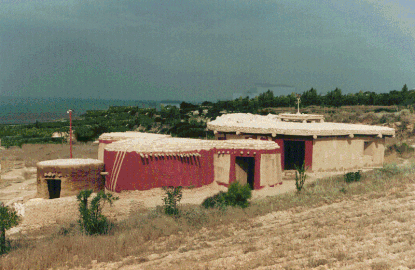Main Archaeological Sites to Visit
Below is a map showing some of the major archaeological sites on Cyprus that are open to visitors. The sites represent all periods and some have visitor centres associated with them that offer guidebooks and many of the sites are increasingly well signposted. In essence you should try to visit at least one of these sites during your stay in Cyprus to gain an understanding of the history of Cyprus.
There are two further points that are probably worth bearing in mind. Firstly and most importantly try and look past the modern and see the site from the historical point of view. Try to cut out out the other tourists, the tavernas and hotels on the skyline and you will have a much deeper experience. Secondly site preservation is from my own experience extremely difficult on Cyprus. The native flora can grow extremely quickly and an aggressive and expensive weeding policy is needed. Shelters often need to be large and heavy looking. The flash floods and sudden squalls of Cyprus can quickly destroy delicate archaeological remains as well as their protective covers.

Cyprus Sites
Nicosia
The walled city of Nicosia has much to offer and it is well worth taking the time to stroll through the atmospheric inner city. Bear in mind of course that the city is divided and you will have to pass through the Green Line if you wish to visit the northern side. The moat of the city now contain gardens and recreation areas. The House of the Dragoman on Patriarch Gregorios Street is a fine example of urban Ottoman Architecture that is open to visitors. There is the Archbishops Palace, which is easy to spot with its large statue to Archbishop Makarios outside, and the associated Byzantine and Folk Art Museums. Also just outside the city walls close to the Paphos Gate is the Cyprus Museum with its wonderful collection of Cypriot antiquities from all over the island.
Kition
Much of the modern city of Larnaca has been built over the ancient city of Kition that dates back to the Bronze Age. These remains have been excavated at a number of points in the city and are still visible. Close to the District Museum, is the Ancient Acropolis whilst to the north west there are two further areas. As well as visiting the District Museum, the private Pierdies Collection Museum is also highly recommended.
Hala Sultan Tekke
Many tourists fly in to Larnaca Airport and can catch a glimpse of the Hala Sultan Tekke shimmering in the heat by the Salt Lake. This is the Tomb and Mosque of Umm Haram, the maternal aunt of the Prophet Mohammed, and one of the most important Muslim shrines in the world.
Chirokitia
Chirokitia is one of the oldest sites on Cyprus, but not the oldest. It is an impressive site though occupying much of hillside looking down on the modern motorway. It is a convenient place to stop when travelling between Cypriot cities. There are reconstructions of some of the buildings that help to give you a better idea of living inside one of these roundhouses. The site has been excavated by a French team for many years.
Kalavasos Tenta
It is possible to take in the site of Kalavasos Tenta in the same trip as Chirokitia as it is situated just off the next junction of the motorway and you can take the old road that goes between the two quite easily. Dated to the Neolithic it contained one of the treasures of Cyprus. A wall painting with with two human figures side by side with their arms raised was painted in red ochre on Structure 11. There were lots of different round houses found here and the distinctive modern cover attempts to shield the remaining remnants from the harsh conditions. From the site you can also look down on the nearby site of Kalavasos Ayios Dhimitrios, one of the large Late Bronze Age cities of Cyprus that continues on and under the motorway.





















